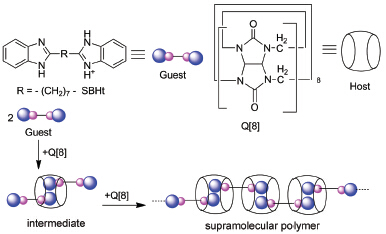| [1] Freeman, W. A.; Mock, W. L.; Shih, N.-Y. J. Am. Chem. Soc. 1981, 103, 7367. [2] Day, A. I.; Arnold, A. P. WO 0068232, 2000,[Chem. Abstr. 2000, 133, P362775k]. [3] Kim, J.; Jung, I. S.; Kim, S. Y.; Lee, E.; Kang, J. K.; Sakamoto, S.; Yamaguchi, K.; Kim, K. J. Am. Chem. Soc. 2000, 122, 540. [4] Day, A. I.; Blanch, R. J.; Arnold, A. P.; Lorenzo, S.; Lewis, G. R.; Dance, I. Angew. Chem., Int. Ed. 2002, 41, 275. [5] Cheng, X. J.; Liang, L. L.; Chen, K.; Ji, N. N.; Xiao, X.; Zhang, J. X.; Zhang, Y. Q.; Xue, S. F.; Zhu, Q. J.; Ni, X. L.; Tao, Z. Angew. Chem., Int. Ed. 2013, 52, 7252. [6] Huang, Y.; Tao, Z.; Xue, S. F.; Zhu, Q. J. Chem. J. Chin. Univ. 2011, 32, 2022. (黄英, 陶朱, 薛赛凤, 祝黔江, 高等学校化学学报, 2011, 32, 2022.) [7] Kim, K. Chem. Soc. Rev. 2002, 31, 96. [8] Lee, J. W.; Samal, S.; Selvapalam, N.; Kim, H.-J.; Kim, K. Acc. Chem. Res. 2003, 36, 621. [9] Lagona, J.; Mukhopadhyay, P.; Chakrabarti, S.; Isaacs, L. Angew. Chem., Int. Ed. 2005, 44, 4844. [10] Kim, K.; Selvapalam, N.; Ko, Y. H.; Park, K. M.; Kim, D.; Kim, J. Chem. Soc. Rev. 2007, 36, 267. [11] Hwang, I.; Ziganshina, A. Y.; Ko, Y. H.; Yun, G.; Kim, K. Chem. Commun. 2009, 416. [12] Xiao, X.; Wu, M. Q.; Xue, S. F.; Zhu, Q. J.; Zhang, J. X.; Tao, Z. Chin. J. Org. Chem. 2012, 33, 68. (肖昕, 吴明强, 薛赛凤, 祝黔江, 张建新, 陶朱, 有机化学, 2012, 33, 68.) [13] Dong, N.; Wang, X. L.; Pan, J. P.; Tao, Z. Acta Chim. Sinica 2011, 69, 1431. (董南, 王秀林, 盘金品, 陶朱, 化学学报, 2011, 69, 1431.) [14] Wang, Q. S.; Cong, H.; Zhang, J. X.; Tao, Z.; Xue, S. F. Chin. J. Org. Chem. 2011, 31, 1049. (王杞生, 丛航, 张建新, 陶朱, 薛赛凤, 有机化学, 2011, 31, 1049.) [15] Dong, N.; Xue, S. F.; Tao, Z.; Zhao, Y.; Cai, J.; Liu, H. C. Acta Chim. Sinica 2008, 66, 117. (董南, 薛赛凤, 陶朱, 赵昱, 蔡洁, 刘洪材, 化学学报, 2008, 66, 117.) [16] Zhu, G. M.; Yang, L. Y.; Cui, D. M. Chin. J. Org. Chem. 2014, 34, 495. (朱观明, 杨柳阳, 崔冬梅, 有机化学, 2014, 34, 495.) [17] Peng, P.; Xiong, J. X.; Li, B.; Mo, G. Z.; Chen, R. H.; Wang, C. Y. Chin. J. Org. Chem. 2013, 33, 1891. (彭湃, 熊金锋, 李豹, 莫广珍, 陈任宏, 汪朝阳, 有机化学, 2013, 33, 1891) [18] Mao, Z. Z.; Wang, C. Y.; Hou, M. N.; Song, X. M.; Luo, Y. F. Chin. J. Org. Chem. 2008, 28, 542. (毛郑州, 汪朝阳, 侯美娜, 宋秀美, 罗玉芬, 有机化学, 2008, 28, 542.) [19] Biedermann, F.; Rauwald, U.; Cziferszky, M.; Williams, K. A.; Gann, L. D.; Guo, B. Y.; Urbach, A. R.; Bielawski, C. W.; Scherman, O. A. Chem. Eur. J. 2010, 16, 13716. [20] Pischel, U.; Uzunova, V. D.; Remon, P.; Nau. W. M. Chem. Commun. 2010, 46, 2635. [21] Yi, J. M.; Zhang, Y. Q.; Xue, S. F.; Zhu, Q. J. Acta Cryst. 2008, E64, o696. [22] Sinha, M. K.; Reany, O.; Parvari, G.; Karmakar, A.; Keinan, E. Chem. Eur. J. 2010, 16, 9056. [23] Zhang, Z. J.; Zhang, Y. M.; Liu, Y. J. Org. Chem. 2011, 76, 4682. [24] Ge, J. Y.; Xue, S. F.; Zhu, Q. J.; Tao, Z.; Zhang, J. X. J. Inclusion Phenom. Macrocyclic Chem. 2007, 58, 63. [25] De Greef, T. F.; Smulders, M. M. J.; Wolffs, M.; Schenning, A. P. H. J.; Sijbesma, R. P.; Meijer, E. W. Chem. Rev. 2009, 109, 5687. [26] Aida, T.; Meijer, E. W.; Stupp, S. I. Science 2012, 335, 813. [27] Harada, A.; Takashima, Y.; Yamaguchi, H. Chem. Soc. Rev. 2009, 38, 875. [28] Dong, S.; Luo,Y.; Yan, X.; Zheng, B.; Ding, X.; Yu, Y.; Ma, Z.; Zhao, Q.; Huang, F. Angew. Chem., Int. Ed. 2011, 50, 1905. [29] Zhang, Z.; Luo, Y.; Chen, J.; Dong, S.; Yu, Y.; Ma, Z.; Huang, F. Angew. Chem., Int. Ed. 2011, 50, 1397. [30] Yan, X.; Xu, D.; Chi, X.; Chen, J.; Dong, S.; Ding, X.; Yu, Y.; Huang, F. Adv. Mater. 2012, 24, 362. [31] Wang, F.; Han, C.; He, C.; Zhou, Q.; Zhang, J.; Wang, C.; Li, N.; Huang, F. J. Am. Chem. Soc. 2008, 130, 11254. [32] Wang, F.; Zhang, J.; Ding, X.; Dong, S.; Liu, M.; Zheng, B.; Li, S.; Wu, L.; Yu, Y.; Gibson, H. W.; Huang, F. Angew. Chem., Int. Ed. 2010, 49, 1090. [33] Zhang, M.; Xue, D.; Yan, X.; Chen, J.; Dong, S.; Zheng, B.; Huang, F. Angew. Chem., Int. Ed. 2012, 51, 7011. [34] Ji, X.; Yao, Y.; Li, J.; Yan, X.; Huang, F. J. Am. Chem. Soc. 2013, 135, 74. [35] Ji, X.; Dong, S.; Wei, P.; Xia, D.; Huang, F. Adv. Mater. 2013, 25, 5725. [36] Zhang, J.; Coulston, R. J.; Jones, S. T.; Geng, J.; Scherman, O. A.; Abell, C. Science 2012, 335, 690. [37] Liu, Y. L.; Huang, Z. H.; Tan, X. X.; Wang, Z. Q.; Zhang, X. Chem. Commun. 2013, 49, 5766. [38] Tan, X. X.; Yang, L.L.; Liu, Y. L.; Huang, Z. H.; Yang, H.; Wang, Z. Q.; Zhang, X. Polym. Chem. 2013, 4, 5378. [39] Liu, Y. L.; Huang, Z. H.; Liu, K.; Kelgtermans, H.; Dehaen, W.; Wang, Z. Q.; Zhang, X. Polym. Chem. 2014, 5, 53. [40] Yang, L. L.; Liu, X. G.; Tan, X. X.; Yang, H.; Wang, Z. Q.; Zhang, X. Polym. Chem. 2014, 5, 323. [41] Yang, H.; Ma, Z.; Wang, Z. Q.; Zhang, X. Polym. Chem. 2014, 5, 1471. [42] Li, L. F.; Lin, Y. W.; Huang, Z. W.; Luo, H. B. Chem. J. Chin. Univ. 2012, 33, 282. (李立凡, 林友文, 黄智文, 罗红斌, 高等学校化学学报, 2012, 33, 282.)Ni, X. L.; Xiao, X.; Cong, H.; Zhu, Q. J.; Xue, S. F.; Tao, Z. Acc. Chem. Res. 2014, 47, 1386. |
